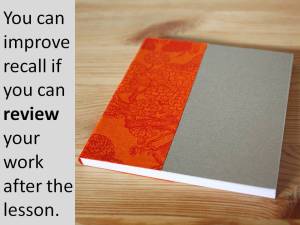There’s all kinds of research into how we can retain information better. Over a few minutes, we can rehearse it: saying a line of poetry aloud or muttering a phone number under our breath. But if we’re going to have a chance of remembering it in the long term, then we need to do a little more. One of the best approaches is to use the information or practice the skill soon after first learning it. This isn’t revision – reviewing should happen almost immediately after the lesson, within hours or days.
There are many different ways to do this, and what you choose to use will depend both on your preferences and the subject you’re working on. A general guideline is that the more active the method is – the more you have to think about or use the material – the better it will work. (Obviously this applies in lessons and during revision as well.) This, by the way, is the principle behind useful homework assignments.
In five minutes
- read through notes, adding examples or applications and highlighting important points
- write a summary, using C words (Concept, Cues, Context, Causes, Consequences)
- complete a Cornell notes page that you started in a lesson
- find two useful web pages and bookmark them (in an organised way)
- add key words with definitions/explanations to your revision checklist or glossary
- take photos of the main points on your phone – instant revision card
- write three sentences explaining how it links to other subjects
- write a question to test yourself with later, and a model answer
- using a textbook or revision guide, link the content to previous material
- read ahead to check what’s coming next
These and other review methods can be seen in the archive of blog posts. Note that most leave some kind of visible evidence, which will probably be saved for future study or revision.
